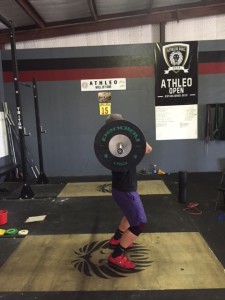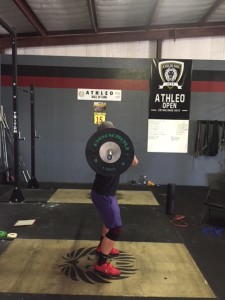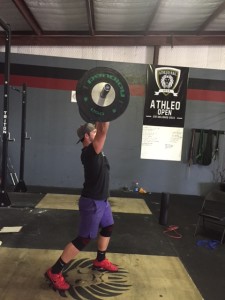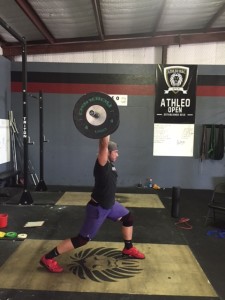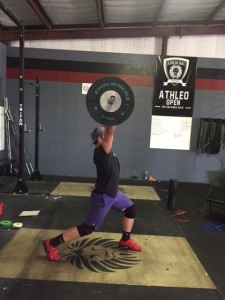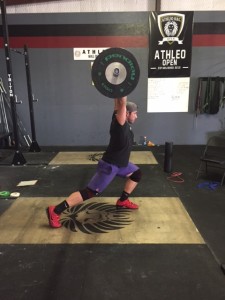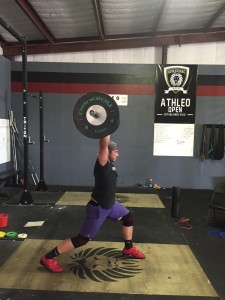One thing I have noticed, specifically amongst the CrossFit population, is that they typically can clean more than they split jerk. Even at the CrossFit Games during the Clean and Jerk ladder, athletes were failing to be able to jerk the weight more often than they were failing to clean it. I attribute this to the fact that most CrossFit athletes tend to do more far more cleans than they do jerks. I always see people giving specific time to improve their clean technique, but rarely see people working on their split jerk. There is also far less sources to be found on split jerk technique. In my opinion, the split jerk is just as technical of a lift as the snatch and clean, and should be treated as such. Below are the most common faults I see in the split jerk. I have listed them in order as they tend to happen. This means there’s a good chance if you fix one of them, you very well may fix some of the others below them. At the bottom I will also include a split jerk progression I use with my athletes to address the key points of the lifts. Everyone loves the feeling of putting something heavy over their head, and the split jerk is the most efficient way to do so. Give your split jerk the time it deserves and reap the rewards. Happy lifting!
1. NOT SETTING YOUR MIDLINE – You want to take a deep belly breath and fill up your whole diaphragm and then push out. If done correctly your belly should expand as you take your breath in and your whole midline should expand out like a balloon in all directions as you brace. This will help you keep your ribcage tucked down and give you stability overhead as you receive.
2. DIP AND DRIVE IS FORWARD – This is one of the most common faults I see, which can cause a domino effect of many of the latter faults. This can be caused by dipping too fast, letting your elbows drop during the dip, or simply pushing your knees and hips too far forward during the dip. Before starting the dip you want to be sure you have moved your elbows down and out. When you dip your torso should remain vertical, with your hips staying underneath you and your weight staying midfoot to heal. You want the dip to be smooth and controlled. As you drive up your hips should travel back up in the same manner as the came down and your weight should stay in the heels for as long as possible. Athletes often shift to their toes too soon causing them to finish forward and push the bar out front.
3. NOT PUSHING YOURSELF UNDER THE BAR/SPLIT TOO SHALLOW – Many athletes struggle to change the direction of their efforts from driving the bar up with their legs to then pushing themselves under the bar. I often see people continue to drive up and end up in a awkward push press with a small split and large press out. Its far less about how high you can press the bar and more about how quickly you can drive yourself under the bar into a stable catch.
4. NOT FINISHING WITH THE BAR OVER BASE OF SUPPORT – This is usually a by-product of the above fault but can also be a mobility issue. When receiving the jerk it should be directly over the base of your neck. Often time athletes will fail to shift under the bar correctly and will leave their heads too far behind the bar creating an unstable position as well as putting too much stress on the back.
5. FRONT FOOT HITTING FIRST – Your back foot should hit the floor just before your front foot does. Some may hit at the same time, but you cannot hit front foot first. When your front foot hits first it causes you to be pushed back behind the bar, as supposed to being pushed under.
6. FRONT SHIN NOT VERTICAL/TOO MUCH WEIGHT ON FRONT FOOT – This is probably the most common mistake I see, although if you have fixed the above faults, this one may already have fixed itself. There is no wiggle room here. Your front shin must be vertical in the split jerk. A forward front shin always indicates there is too much weight on the front foot, therefore you are forward. You want your weight balanced over your hips (where the load should also be over). This means you should have about 55/45-60/40 front to back foot weight ratio. This ratio should allow you to recover with your front foot first. If you recover back foot first you run a much higher risk of missing the weight out front.
Here is a good progression to use before you train your split jerks to work on getting into ideal positions during the different phases of the lift.
[youtube]https://www.youtube.com/watch?v=advFJeZArN8[/youtube]
Press from split
Jerk from split
Segmented jerk
Pause jerk
– The content for this blogpost was written by Seth Walker and Thacher Riddle, Premier’s USAW Lifting Coaches. If you’d like to improve your Olympic lifting skills, join us for our Athleo Barbell Club!
Go to: http://www.premiercrossfit.com/programs/athleo-barbell-club/

